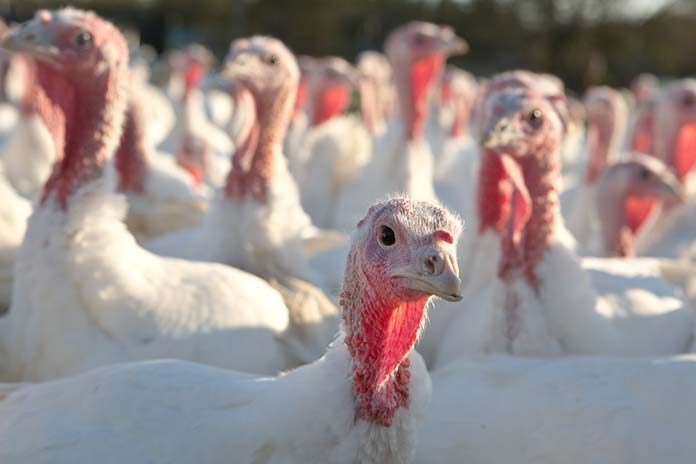
Traditionally, the turkey industry focuses on meat production rather than egg production. However, each turkey poult that is raised from meat production originated from a fertile egg.
Aside from overall lowered egg production, extensive variation in egg production exists within a single flock, creating low egg producing hens (LEPH) and high egg producing hens (HEPH). LEPH impact the turkey industry’s breeding farms and are costing the industry roughly $50 million a year in lost poult production. From an industry standpoint, HEPH would provide breeding farms with larger numbers of poults for rearing, ultimately making the industry more productive and profitable.
At an endocrine level, the hypothalamo-pituitary-gonadal axis, or the HPG axis, controls the beginning step of egg production, follicle ovulation. Each egg laid begins with ovulation of a follicle from the hen’s ovary into the oviduct for egg development, making egg production and ovulation highly correlated. Ovulation is triggered by a preovulatory surge (PS) of luteinizing hormone and progesterone, produced mainly byc the pituitary and granulosa cells of the ovulating follicle, respectively. Stimulation of the HPG axis leads to the PS. Gonadotropin releasing hormone produced in the hypothalamus stimulates luteinizing hormone production in the pituitary, which, in turn, causes progesterone production in the granulosa cells of the follicle. The HPG axis can also be negatively regulated by gonadotropin inhibitory hormone, which blocks both gonadotropin releasing hormone and luteinizing hormone production.
The gonadal component of the HPG axis, the ovary, is composed of follicles in varying degrees of maturation. The preovulatory follicles are termed F1 through F8-F10 based on follicle size, with the F1 follicle next in line to respond to the PS and ovulate. Once a follicle has ovulated, egg production in the oviduct begins and ends with an egg laid 26 hours later. Within the follicle wall of a preovulatory follicle, there are three different cell types with specialized roles in steroid production. The granulosa cells produce progesterone, the theca interna cells produce androgens, and the theca externa cells produce estrogen. During steroidogenesis, cholesterol is converted to progesterone by steroidogenic acute regulatory protein (STAR), cholesterol side chain cleavage enzyme (CYP11A1), and 3β-hydroxysteroid dehydrogenase (HSD3B1). Progesterone can be further converted to testosterone by 17,20 lyase (CYP17A1) and 17β-hydroxysteroid dehydrogenase (HSD17B1). Lastly, testosterone can be converted to estradiol by aromatase (CYP19A1).
Results
When first comparing LEPH and HEPH, significant differences in egg production, clutch length, pause length, and ovulation interval were noted. As expected HEPH exhibited a higher number of eggs laid per day when compared to LEPH. Clutch length, which is the number of eggs laid consecutively, was also higher in HEPH than LEPH. Moreover, pause lengths, which is the number of days between clutches, was lower in HEPH in contrast to LEPH. Lastly, ovulation interval, which is the time between ovulations, was greater in LEPH when compared to HEPH. No differences were observed in age at first egg lay, length of the laying cycle, or in body weight.
Despite significant differences in production parameters, morphologically the ovaries from LEPH and HEPH look very similar. Similar to the morphological structure, ovarian and plasma parameters did not differ between LEPH and HEPH. The ovaries of LEPH and HEPH did not differ in the number of preovulatory follicles, the weight of the F1 follicle, or the size of the SWF. Furthermore, the ovary and oviduct weights were not different between LEPH and HEPH. Plasma parameters, such as basal progesterone levels and progesterone levels during the PS did not differ between LEPH and HEPH. Though differences in egg production rates, clutch length, and pause length in LEPH and HEPH were not seen, a reason for these differences was not seen when the morphological structure, ovarian parameters, and plasma parameters were examined. Through these observations, common reasons for lowered egg production, such as reduced follicle numbers, signs of follicle atresia, an abnormal follicular hierarchy, or atypical steroid hormone levels, were ruled out.
As no gross morphological differences were found between LEPH and HEPH, we hypothesized that functional differences in the hypothalamus, pituitary, and gonadal components of the HPG axis were responsible for differential egg production. We examined expression of key genes of the HPG axis during the ovulatory cycle in LEPH and HEPH.
In the hypothalamus, LEPH exhibited higher mRNA levels for GNIH. In the pituitary, significant differences were seen in the mRNA levels of the FSHB, LHB, and GNIHR. HEPH exhibited higher mRNA levels FSHB and LHB. LEPH displayed higher mRNA levels of GNIHR. In the F1 granulosa cells, significant expression differences were seen in two of the three enzymes required for progesterone production.
Hens with low egg production demonstrated decreased mRNA levels for STAR and CYP11A1. In the F5 theca interna cell layer, differences in mRNA levels were significant for both genes involved in androgen production. LEPH exhibited higher mRNA levels for both CYP17A1 and HSD17B1 when compared to HEPH. In the SWF cells, significant differences were seen in the expression of all three of the enzymes required for estradiol production. HEPH demonstrated increased mRNA levels for the genes coding for CYP17A1, HSD17B1, and CYP19A1.
Implications
In conclusion, LEPH and HEPH exhibited different degrees of stimulation and inhibition in all of the tissues of the HPG axis at the mRNA level. Increased egg production was associated with increased ovulation stimulation, exhibited by LHB and FSHB expression. Increased egg production was also associated with decreased ovulation inhibition, seen in lowered expression of GNIH and GNIHR. In the ovarian follicle cells, increased egg production was associated with increased progesterone, decreased androgen, and increased estradiol production in the F1 granulosa layer, F5 theca interna layer, and SWF, respectively.
Further investigation will be required to determine the mechanisms by which these established differences ultimately impact egg production. The project has implications in the identification of genetic markers that could be utilized in breeding programs to increase egg production rates in turkey hens. Feasibility of increased egg production, in terms of fertility rates and the impact of increased egg production on growth traits, also needs to be evaluated further.
References are available on request
From the 2019 MPF Proceedings – Midwest Poultry Federation Convention














